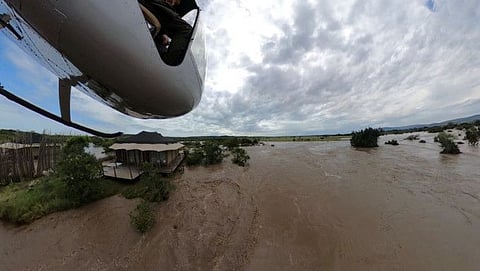Flood-hit Kenya reports dozens of cholera cases
Death toll 257; 55,000 households displaced as floodwaters engulf homes, roads, bridges

NAIROBI: The United Nations voiced concern on Wednesday after dozens of cases of cholera were reported in flood-stricken Kenya as the death toll from rain-related disasters surpassed 250.
The World Health Organization (WHO) said 44 cases of the disease have been reported in Tana River County in eastern Kenya, one of the areas hardest hit in weeks of destructive rains and flooding.
“I believe that between government and national and international partners, we’ll be able to contain it,” the UN’s resident coordinator in Kenya, Stephen Jackson, said in an interview with Citizen TV.
“We’ve contained cholera before, but it’s a significant concern,” he added.
Cholera is an acute intestinal infection that spreads through contaminated food and water and typically causes severe diarrhoea, vomiting and muscle cramps.
It can be especially dangerous for young children.
“WHO will continue to support the health emergency response and remain vigilant for disease outbreaks that can easily spread if not quickly contained,” Abdourahmane Diallo, WHO representative in Kenya, said in a statement issued by the UN’s health agency on Tuesday about the 44 cases.
“We must be agile and ready to respond, led by government and along with the partners, to bring relief to hundreds and thousands of affected people,” Diallo said.
Death toll rises
The death toll since March has climbed to 257, according to Kenyan government spokesman Isaac Mwaura.
Across the country nearly 55,000 households have been displaced as floodwaters and mudslides engulfed homes, roads and bridges.
But President William Ruto announced that schools would reopen next Monday after a two-week delay, saying the rains had now subsided and it was safe for children to return to class.
He also declared that Friday would be a public holiday to remember those lost in the floods and to kickstart an extensive tree-planting programme.
Ruto, who has positioned himself at the forefront of African efforts to combat climate change, has blamed the region’s calamitous cycle of drought and floods on a failure to protect the environment.
Overall, the heavier than usual seasonal rains, compounded by the El Nino weather phenomenon, have claimed the lives of more than 400 people in East Africa, a largely poor region highly vulnerable to climate change.
“The unprecedented and devastating flooding has unveiled the harsh realities of climate change, claiming lives and displacing communities,” said Rana Jaber, regional director for East and Horn of Africa at the UN’s International Organization for Migration (IOM).
‘Alarm’ over looming drought
Late last year, more than 300 people died in rains and floods in Ethiopia, Kenya and Somalia, just as the region was trying to recover from its worst drought in four decades that left millions of people hungry.
The UN’s Jackson warned of a “significant risk” of another drought, according to long-range forecasts.
“So it’s a point of alarm. It’s not yet a certainty. What is a certainty is, given the climate crisis, that there will be a drought along again this year or next year or the year after,” he said.
“We know that these are coming harder and harder and faster and faster.”
Meanwhile, all residents of a five-storey apartment block on the edge of the Kenyan capital that collapsed on Tuesday night are safe, according to local authorities.
Sign up for the Daily Briefing
Get the latest news and updates straight to your inbox



